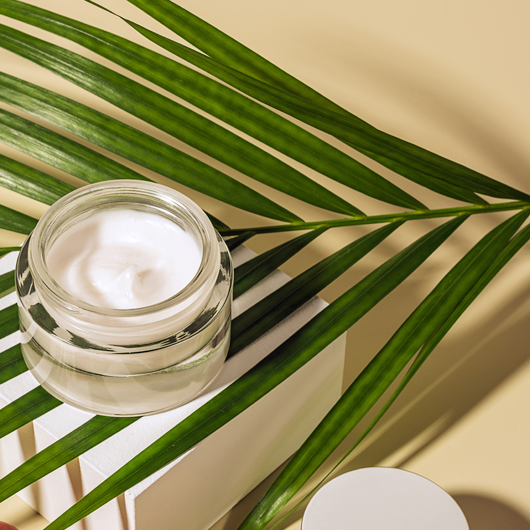Having sensitive skin means that your complexion will let you know immediately if something in your diet, lifestyle, or skincare regimen is not right. Redness and bumps are common signs.
Although we often think of sensitive skin as problematic, we should stop and realize that “sensitive” skin is working as it should be, letting you know that something is wrong.
It is not a sign that something is wrong with you; it is, instead, a sign that something is wrong with the choices you are making.
Characteristics of Sensitive Skin:
- Develops rashes
- Blushes easily
- Overacts to extreme temperatures
- Sunburns quickly
- Rosacea
- Thread veins (couperose skin)
- Tends to be normal-to-dry or very dry
Tips for Sensitive Skin:
Avoid Using:
- Alcohol-based toners
- Gritty facial scrubs
- Herbal Steams
- Drying clay masks
- Stimulating herbs
- Alpha hydroxy and glycolic acids
- Synthetic fragrance
- Artificial preservatives
- Extremes of heat or cold
- Terry washcloths and coarse sponges
- Tanning
5 Ingredients of Less:
Because sensitive skin often tends to be dry, it is essential to use a gentle cleanser, free of harsh surfactants, often found in commercial cleaners.
1) An excellent choice for sensitive skin is an oil-based cleanser, which will gently loosen debris on the skin’s surface. Here are 3 DIY options for making a custom cleanser:
Oil-Based Cleanser:
A few drops of lavender, chamomile, or rose geranium essential oil added to a carrier oil, such as coconut, apricot kernel, sunflower, sweet almond, or extra virgin olive oil, makes a gentle and efficient cleansing or pre-cleansing oil.- Lavender essential oil is antibacterial and soothing.
- Chamomile essential oil is calming and anti-inflammatory.
- Rose geranium essential oil is balancing.
2) If a soap-based cleanser is preferred, a Castile-based cleanser can be used. It's a safe alternative to a soap-based cleanser as it does not contain harsh surfactants that strip the skin of its natural oils. It is best for normal, normal-oily, and oily skin sensitivities to surfactants and other chemicals, including synthetic preservatives that can be found in many commercial facial washes. Although, it can be used for dry skin if aloe and vegetable glycerin is added.
Castile Cleanser:
- A ½ cup of pure liquid Castile soap
- ½ cup distilled water, flower water, or hydrosol.
- For extra moisturizing properties, add 1-2 tablespoons of vegetable glycerin.
- For moisturizing and pH-balancing properties, add 1-2 tablespoons aloe vera gel or juice.
- A few drops of chamomile, lavender, or rose geranium essential oil can also be added depending on your skin's specific needs.
3) Many people prefer a cream cleanser, which is also referred to as a cold cream. It is good for dry and dry to normal skin, although some people may be sensitive to the sodium borate, a naturally occurring chemical compound. It gives the cream its cleansing properties. (In the below recipe, it is used in minimal amounts)
Simple Cleansing Cream:
- 4 oz sweet almond oil
- 5 Tablespoons water
- 2 Tablespoons beeswax
- ¼ Teaspoon borax
- On low heat, place a pot of water, then another pan over it just like you were making candy.
- Keep on low heat and add the wax, stir until a liquid is formed, then add the oil.
- Turn off the heat and remove it from the stove.
- Pour water into a small pot and warm over low heat.
- Add borax.
- Stir to blend.
- Once the borax is dissolved in the water, pour it slowly into the oil and wax mixture, continually stirring until thickened.
- Place in a dark glass jar.
- Do not cap until the cream is completely cooled.
Gentle Exfoliation for Sensitive Skin:
Often, people think that they have dry skin when they feel a buildup of dead skin cells on the skin's surface. If there is a buildup of dead skin cells on the skin's surface, the moisturizer will not adequately penetrate the pores. Moisturizing dead skin cells will do no good whatsoever. Exfoliating can remove dead skin cells. Just use a gentle scrub once a week. It is to be applied after cleansing and before toning to remove any build-up of dead skin cells that may cling to the skin's surface.
The best ingredients to use for a gentle exfoliating scrub include:
- Finely ground oatmeal
- Almond meal
- Cornmeal
- White clay
- Ground lavender buds, chamomile flowers, or rose petals
- Milk powder
- Mix any one or a combination of the dry ingredients.
- Place mixture in an airtight container.
- Use 1 Tablespoon of mixture per application.
- Add enough water to make a paste.
- Allow setting for one minute.
- Apply to skin.
- Massage into skin in a circular motion.
- Do not apply pressure.
- Rinse thoroughly with tepid water.
- 4 Tablespoons ground oatmeal
- 3 Tablespoons cornmeal
- 1 Tablespoon ground lavender buds
- 1 Tablespoon powdered milk
Milk contains lactic acid, which helps to dissolve dead skin cells and soften the skin. Never over-exfoliate sensitive skin as it can cause damage to the skin’s surface. Exfoliating one time per week should be sufficient for those with dry or sensitive skin.
Correct pH Skincare:
Although many, if not most, people skip this step, toning is an essential part of your skincare regimen. A good, non-drying toner will balance the skin’s pH, lessen pores' appearance, counteract inflammation, and help retain a healthy moisture barrier. Do not use toners that contain alcohol.
The best toners for sensitive skin are:
- pure witch hazel extract
- flower water
- hydrosol
- brewed and cooled green tea
- Infusion of Calendula (marigold) flowers
- a combination of any of the above
All of these ingredients can be cut by adding equal parts of distilled water. Place the mixture in a glass bottle with a spray top and spritz onto the skin after cleansing. While the skin is still slightly damp, apply a moisturizer. The toner will act as a vehicle to pull the moisturizer into your skin without leaving an oily residue.
There are two types of dehydration of the skin, lack of moisture from not enough water intake, and lack of moisture from insufficient oil (sebum) production. Toning is just as important to building the skin's moisture barrier as moisturizing is because the skin needs both. Toning builds the skin's moisture barrier and pulls the moisturizer deep into the skin so that it does not just lay on the surface of the skin.
Many people worry about using oil on their skin because they are afraid that it will make their skin appear and feel greasy and possibly cause blocked pores. This is why people like to use moisturizing creams. The truth is, a cream moisturizer is simply an emulsified oil and water blend. An emulsifier combines the oil and water mixture in order to create a cream, much like using flour to blend pan drippings, broth, and water to make a gravy.
I find that it is always much more simple to use ingredients that are close to the source. Once water is introduced, the product becomes less stable. It limits the shelf life of the product. This is why synthetic preservatives are used in commercial products.
The closer your skin care products are to their original source, the better they are for you.
Moisturizer is a Must-Have:
Moisturizing sensitive skin is quite easy. People with sensitive skin can get away with just the basics. The more ingredients in skincare products, the more likely there will be adverse reactions. Where the delicate skin is concerned, it is best to keep it simple.
4 Good moisturizers include:
- Coconut oil – antibacterial, antifungal, antiviral; helps soothe broken capillaries.
- Apricot kernel oil – antioxidant; inhibits cell harm by free radicals in the body caused by UV rays, smoke, chemicals, and the environment.
- Sunflower oil – contains beta-carotene (avoid beta-carotene if allergic to beta-carotene, on cholesterol-lowering meds, or if you smoke chemically treated tobacco) an antioxidant; helps to neutralize free radicals that can penetrate and lead to sunburn, sun damage, and cancer; prevents premature signs of aging.
- Shea butter – restores skin’s elasticity; has antioxidant properties.
Only small amounts are needed. These oils can be further customized by combining or adding essential oils specific to your skin’s needs.
When should you cleanse, tone & moisturize?
Sensitive skin often becomes reddened just from cleansing. If this is the case, cleanse, tone, and moisturize at night before bed. In the morning, splash your face with tepid water, pat dry, and apply toner and a light moisturizer.
Wait 3-5 minutes after moisturizing before applying makeup to give the moisturizer time to penetrate the skin. If not, it is okay to cleanse, tone, and moisturize every morning and evening and to use a gentle facial scrub once a week.
Note:
It is important to avoid overexposure to the sun and extremes in temperature. Always use tepid water to wash, bathe, or shower. (Tepid is a mixture of two parts cold to one part boiling water- i.e., Luke Warm)
Please also try to avoid processed foods, any consumables that have been chemically treated, and personal care products and cosmetics that contain known toxins.
And make it your mission to learn more about what is in your products and how to make better choices.
Article Graciously Contributed By:
Lissa Bell
Independent Licensed Managing Esthetician Holistic Skin Care Practitioner








